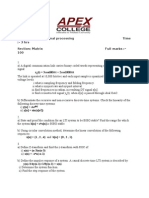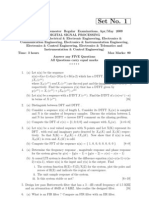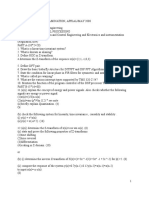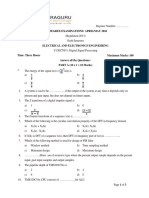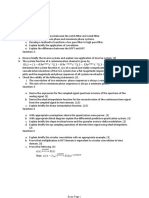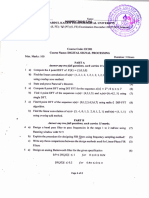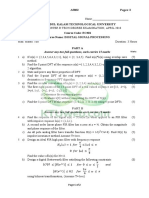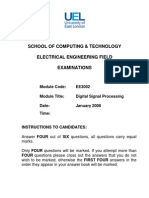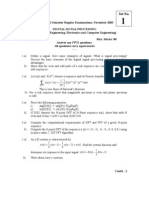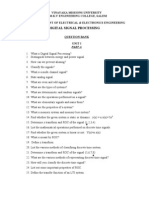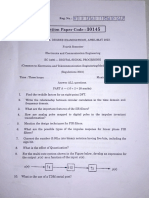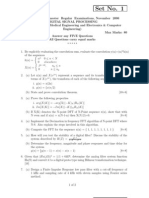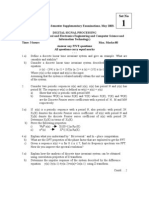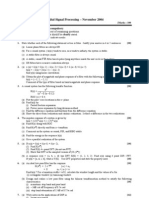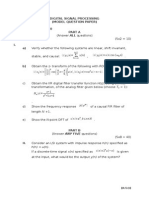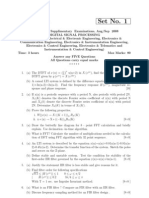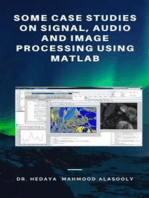Digital Signal Processing 1
Uploaded by
Anil RaiDigital Signal Processing 1
Uploaded by
Anil RaiPOKHARA UNIVERSITY
Level: Bachelor Semester Fall Year : 2005
Programme: BE Full Marks: 100
Course: Digital Signal Processing Time : 3hrs.
Candidates are required to give their answers in their own words as far
as practicable.
The figures in the margin indicate full marks.
Attempt all the questions.
1. a) Define recursive and non-recursive discrete-time systems. Check the
linearity of the following discrete-time systems:
i) y(n) = A x (n) + B
ii) y(n) = A e
x(n)
b) Consider an analog signal
x
a
(t) = 3 cos 2000
t + 5 sin 6000
t + 10 cos 12000
t
i) What is the Nyquist rate for this signal?.
ii) Assume that we sample this signal; using sampling rate Fs =
5000 samples/sec. What is the discrete time signal obtained
after sampling?
iii) What is the analog signal we can reconstruct from the
samples if we use ideal interpolation?
2+2
+2
3+3
+3
2. a) Differentiate the causal discrete-time system from the non-causal
discrete-time system. Check whether the following discrete time
systems are causal or not.
i.) y (n) = Ax (n) + B
ii.) y (n) = x(n) + 3x (n-1) + 4x (n +2)
b) Consider a system described by the difference equation y (n) = y (n-1)
y (n-2) + 0.5 x(n) + 0.5 x (n-1)
Find the response of this system to the input x (n) = (0.5)
n
u(n)
with initial conditions y (-1) = 0.75 and y (-2) = 0.25.
3+2
+2
8
3. a) Define z-transform. Determine the z-transform and ROC of signal
x(n) = [3(2
n
) 4 (3
n
)] u (n)
b) Use the z-transform to perform the convolution of the following two
sequences:
7
8
h(n) =
'
,
`
.
|
e l s e
n
n
0
2 0
2
1
and x(n) = (n) + (n-1) + 4 (n-2)
4. a) Given a sequence x(n) = (-1)
n
, write the equations for decimationin
time algorithm for N = 4 and draw the signal flow graph.
b) Perform the circular convolution of the following two sequences:
x
1
(n) = {1, 2, 1, 2}
and x
2
(n) = { 1, 3, 2, 5}
8
7
5. a) For a discrete-time system
), ( ) ( k n x b k n y a
k k
+
draw the direct-form I
structure. Also draw the corresponding direct form II structure.
b) Determine the lattice coefficient corresponding to FIR filter with
system function
3 2 1
3
3
1
8
5
24
13
1 ) ( ) (
+ + + z z z z A z H
6
9
6. a) Describe the design procedure of linear phase FIR filters by
windowing.
b) Design a digital lowpass Butterworth filter using impulse invariance
method to meet the following specifications:
Pass band edge frequency = 1.25 kHz
Stop band edge frequency = 2.75 kHz
Pass band ripple 0.5dB
Stop band attenuation 15 dB
Sampling frequency = 10 kHz.
10
7. Write short notes on (Any Two)
a) Elliptic filter
b) Pipelined implementations of DSP processors
c) Truncation and Round off errors
25
d) Matched z- transform method of IIR filter design.
You might also like
- Ec301 Digital Signal Processing, December 2023No ratings yetEc301 Digital Signal Processing, December 20232 pages
- Answer Any Two Full Questions, Each Carries 15 Marks: Reg No.: - NameNo ratings yetAnswer Any Two Full Questions, Each Carries 15 Marks: Reg No.: - Name2 pages
- Digital Signal Processing R13 Previous Papers100% (1)Digital Signal Processing R13 Previous Papers5 pages
- Note: Answer All Questions From Part A. Answer Any Five Questions From Part BNo ratings yetNote: Answer All Questions From Part A. Answer Any Five Questions From Part B1 page
- Analog Signal Processing Tutorial 2: Sampling and ReconstructionNo ratings yetAnalog Signal Processing Tutorial 2: Sampling and Reconstruction12 pages
- Set No: 1: Code: V3218/R07 Digital Signal Processing Time: 3 Hours Max. Marks: 80No ratings yetSet No: 1: Code: V3218/R07 Digital Signal Processing Time: 3 Hours Max. Marks: 804 pages
- Model Question Paper - With Effect From 2020-21 (CBCS Scheme)No ratings yetModel Question Paper - With Effect From 2020-21 (CBCS Scheme)4 pages
- Department of Electrical Engineering National Institute of Technology Srinagar Tutorial IIINo ratings yetDepartment of Electrical Engineering National Institute of Technology Srinagar Tutorial III3 pages
- Some Case Studies on Signal, Audio and Image Processing Using MatlabFrom EverandSome Case Studies on Signal, Audio and Image Processing Using MatlabNo ratings yet
- Nonlinear Control Feedback Linearization Sliding Mode ControlFrom EverandNonlinear Control Feedback Linearization Sliding Mode ControlNo ratings yet
- Digital Signal and Image Processing using MATLAB, Volume 3: Advances and Applications, The Stochastic CaseFrom EverandDigital Signal and Image Processing using MATLAB, Volume 3: Advances and Applications, The Stochastic Case3/5 (1)
- Fundamentals of Electronics 3: Discrete-time Signals and Systems, and Quantized Level SystemsFrom EverandFundamentals of Electronics 3: Discrete-time Signals and Systems, and Quantized Level SystemsNo ratings yet
- Standard and Super-Resolution Bioimaging Data Analysis: A PrimerFrom EverandStandard and Super-Resolution Bioimaging Data Analysis: A PrimerNo ratings yet
- Analytical Modeling of Solute Transport in Groundwater: Using Models to Understand the Effect of Natural Processes on Contaminant Fate and TransportFrom EverandAnalytical Modeling of Solute Transport in Groundwater: Using Models to Understand the Effect of Natural Processes on Contaminant Fate and TransportNo ratings yet
- my-latest-Biodata-Final - Graphics DesignNo ratings yetmy-latest-Biodata-Final - Graphics Design3 pages
- Human Disintegration Effect in Photoshop: By, 11 Nov 2011No ratings yetHuman Disintegration Effect in Photoshop: By, 11 Nov 201122 pages

